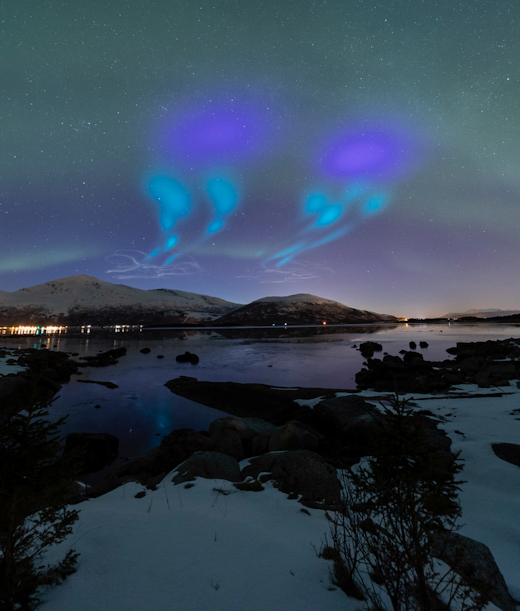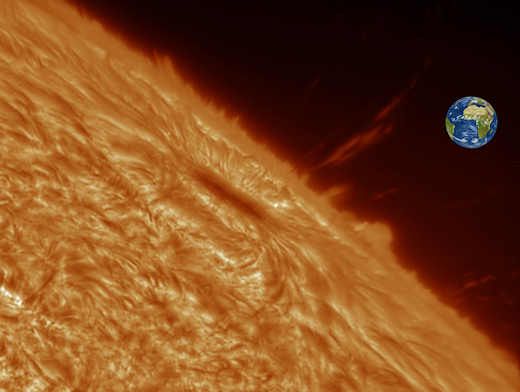The last 2 pictures are dazzling, aren't they ?
Is it known how long this solar minimum will last ? The previous one was 7 years. [Like the superstition of breaking a mirror].
Will this one then get colder and colder before it ends ?
As the Sun Turns: Solar Minimums and Maximums
Re: As the Sun Turns: Solar Minimums and Maximums
- Maria
- Archon
- Posts: 8428
- Joined: Fri 11 June 2004 8:39 pm
- Faith: True Orthodox Christian
- Jurisdiction: GOC
- Location: USA
Re: As the Sun Turns: Solar Minimums and Maximums
Barbara wrote:The last 2 pictures are dazzling, aren't they ?
Is it known how long this solar minimum will last ? The previous one was 7 years. [Like the superstition of breaking a mirror].
Will this one then get colder and colder before it ends ?
We do not know how long this solar minimum will last. It could be that April 2019 will not have very many spotless days with the return of AR2736. I estimate about 11 to 12 spotless days for April at the most. Nevertheless, spotless days could be higher if AR2736 were to suddenly decay as often happens during a solar minimum.
We will have to see what happens in May and June of 2019. If we were to have more sunspots with few spotless days, and if these sunspots were to have the reverse polarity of upcoming solar cycle 25, then the solar minimum might end soon sometime in 2020.
However, during the Dalton Minimum, a mini-ice age, there was a fake out in 1807 when sunspots increased with a corresponding decrease in spotless days. This gave the appearance of an upcoming solar peak, but then the spotless days suddenly increased with almost continuous spotless days forming a very deep solar minimum with lots of cold days. That solar minimum lasted from 1805 to 1815, a total of 10 years.The following solar cycle was also very deep.
See this chart: http://www.sidc.be/silso/yearlyssnplot
The Royal Observatory at Belgium also noticed the coronal loops from old region AR2736.
COMMENT: The Sun did not produce any flares in the past 24 hours. While
NOAA AR 2737 decayed into a plage, the coronal loops from old NOAA region
AR 2736 have appeared at the East limb. The chance for a C flare in the
next 24 hours is estimated at 15%, especially from the returning region at
the East limb.No Earth-directed Coronal Mass Ejections (CMEs) were observed in available
coronagraphic imagery.The greater than 10 MeV proton flux was at nominal levels in the past 24
hours, and is expected to stay at nominal levels in the next 24 hours.Solar wind speed near Earth as registered by DSCOVR varied between about
465 and 535 km/s in the past 24 hours. The Interplanetary Magnetic Field
(IMF) was directed predominantly towards the Sun and its magnitude varied
between about 1 and 7 nT. Bz was never below -5 nT.Quiet to unsettled geomagnetic conditions (K Dourbes between 2 and 3; NOAA
Kp between 2 and 3) were registered in the past 24 hours. Active intervals
(K Dourbes = 4) are possible on April 6 and the first half of April 7, with
a slight chance for minor storm levels (K Dourbes = 5) due to the influence
from isolated negative polarity coronal holes. Quiet to unsettled levels (K
Dourbes < 4) are expected in the second half of April 7 and on April 8.
TODAY'S ESTIMATED ISN : 000, BASED ON 10 STATIONS.
Lord Jesus Christ, have mercy on me a sinner.
- Maria
- Archon
- Posts: 8428
- Joined: Fri 11 June 2004 8:39 pm
- Faith: True Orthodox Christian
- Jurisdiction: GOC
- Location: USA
Re: As the Sun Turns: Solar Minimums and Maximums
Now for the unusual ...
STRANGE LIGHTS OVER NORWAY AND SWEDEN: Last night (April 5th) in Norway, researchers at the Andøya Space Center launched two sounding rockets into a minor geomagnetic storm. The results were out of this world. Aurora tour guide Kim Hartviksen photographed the display:

Photo credit: Kim Hartviksen of Aurora Addicts
"Residents for hundreds of miles were taken by surprise by these strange lights, which prompted a lot of calls to the police and 'The aliens are coming!' hysteria!" says Chris Nation who runs the Aurora Addicts guiding service.
When the night began, Nation, Hartviksen, and their clients were treated to a fine outburst of auroras, ignited by a stream of solar wind buffeting Earth's magnetic field. "As the auroras started to ebb away, our friends at Andøya launched their rockets into the fading lights," says Nation. "The show began anew as the rockets released their payload of fine powders into upper atmosphere."
An automated webcam operated by Chad Blakely of Lights over Lapland in Abisko, Sweden, caught the first puffs of powder emerging from the rockets. "It looked like an invasion of UFOs," says Blakley.
Lord Jesus Christ, have mercy on me a sinner.
- Maria
- Archon
- Posts: 8428
- Joined: Fri 11 June 2004 8:39 pm
- Faith: True Orthodox Christian
- Jurisdiction: GOC
- Location: USA
Re: As the Sun Turns: Solar Minimums and Maximums
Comments from Belgium's Royal Observatory:
COMMENT: Returning region NOAA 2736 at the East limb produced several B
flares. The brightest flare was a B9 flare peaking at 11:00 UT on April 7.
The chance for a C flare in the next 24 hours is estimated at 50%,
especially from returning region 2736.No Earth-directed Coronal Mass Ejections (CMEs) were observed in available
coronagraphic imagery.The greater than 10 MeV proton flux was at nominal levels in the past 24
hours, and is expected to stay at nominal levels in the next 24 hours.Solar wind speed near Earth as registered by DSCOVR varied between about
385 and 530 km/s in the past 24 hours, with current values around 400 km/s.
The Interplanetary Magnetic Field (IMF) was directed predominantly towards
the Sun and its magnitude varied between about 2 and 4 nT, with current
values around 3 nT. Bz was never below -5 nT.Quiet geomagnetic conditions (K Dourbes between 0 and 2; NOAA Kp between 1
and 2) were registered in the past 24 hours. Quiet to unsettled levels (K
Dourbes < 4) are expected in the second half of April 7, and on April 8 and
9.
TODAY'S ESTIMATED ISN : 011, BASED ON 16 STATIONS.
The NOAA GOES X-ray Flux shows:
Maximum at 2019-04-07 11:00:00 UTC
Solar Flare B7.6
Returning AR2736 has been renumbered: AR2738.
:Date: 2019 04 07
Prepared by the U.S. Dept. of Commerce, NOAA, Space Weather Prediction Center
Please send comments and suggestions to SWPC.Webmaster@noaa.gov
#
Missing data: ////
Updated every 5 minutes.
Edited Events for 2019 Apr 07
#
#Event Begin Max End Obs Q Type Loc/Frq Particulars Reg#
#-------------------------------------------------------------------------------10 0351 0355 0358 G15 5 XRA 1-8A B1.6 4.3E-05 2738
20 0637 //// 0640 LEA C RSP 042-144 III/1
30 0831 0840 0853 G14 5 XRA 1-8A B5.3 5.4E-04 2738
40 + 1047 1100 1126 G15 5 XRA 1-8A B7.6 1.3E-03 2738
Reference: https://www.swpc.noaa.gov/products/sola ... nt-reports
Lord Jesus Christ, have mercy on me a sinner.
- Maria
- Archon
- Posts: 8428
- Joined: Fri 11 June 2004 8:39 pm
- Faith: True Orthodox Christian
- Jurisdiction: GOC
- Location: USA
Re: As the Sun Turns: Solar Minimums and Maximums
A BIG NEW SUNSPOT: A new sunspot is rotating over the sun's eastern limb, and it's a big one. Numbered AR2738, the sunspot's primary dark core is big enough to swallow Earth, as shown in this image taken by amateur astronomer Giampaolo Salvato of Padova, Italy:
"I took this picture using my homemade refractor telescope and a Daystar Quantum solar filter," says Salvato. "The picture of Earth is inserted for scale."The magnetic polarity of AR2738 identifies it as a member of old Solar Cycle 24. Apparently, the decaying solar cycle still has some potency. Can this sunspot produce strong flares? We won't know until it turns more directly toward Earth in the days ahead. Then we can see more clearly the structure of its magnetic field and evaluate the potential for explosiveness. Stay tuned
Reference: www.spaceweather.com for April 8, 2018
Per Belgium, the EISN for the month of April, 2019 is approximately 12.
See: http://www.sidc.be/silso/eisnplot
Lord Jesus Christ, have mercy on me a sinner.
- Maria
- Archon
- Posts: 8428
- Joined: Fri 11 June 2004 8:39 pm
- Faith: True Orthodox Christian
- Jurisdiction: GOC
- Location: USA
Re: As the Sun Turns: Solar Minimums and Maximums
AR2738 now has the simple magnetism of an alpha as it has degraded with its transit on the far side of the sun.
Will it become more active as it approaches the western limb of the sun? Time will tell.
In the meantime, it has the magnetic polarity of Solar Cycle 24 and has been actively flaring at the B level.
At 14:00 UT (0700 PDT), it released an impressive impulsive B flare.
Here is the most recent comment from the Belgium Royal Observatory:
COMMENT: Over the past 24 hours solar activity has been low. The largest
flare was a B2.7 class flare. Active Region (AR) 2738 (Mcintosh class:Hsx;
Mag. type:Alpha) has been most active, producing several B-class flares,
including the B2.7 class flare, which peaked at 06:25 UT. Former AR 2737 is
approaching the west solar limb, and has shown little activity. No
significant filament channels have been seen on the solar disk. No Earth
directed Coronal Mass Ejections (CMEs) have been detected. There are no
significant low latitude coronal holes on the solar disk. The greater than
10MeV proton flux remained at background levels over the past 24 hours.
Solar activity is expected to remain low over the next 24 hours with a
reasonable chance of a C-class flare from AR 2738. The region is currently
close to the east solar limb, and it is difficult to assess the associated
magnetogram data.
The solar wind speed has fluctuated between 375 and 400 km/s over the past
24 hours, but jumped up to 450 km/s this morning. The total magnetic field
strength has slowly increased from around 3.5 to approximately 7.5 nT. The
Bz component fluctuated around 0 nT, ranging between -8 and +7 nT.
Geomagnetic conditions ranged between Kp index 1-4 (NOAA) and local K index
1-3 (Dourbes) over the past 24 hours. Kp reached 4 this morning due to the
Bz reaching -8 nT for a short period. Geomagnetic conditions are expected
to be quiet with a small possibility of active conditions.
TODAY'S ESTIMATED ISN : 012, BASED ON 17 STATIONS.
Lord Jesus Christ, have mercy on me a sinner.
